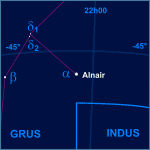
October Constellations
The October sky contains seven constellations, including such well-known formations as Aquarius, the water bearer, and Pegasus, the winged horse. The only notable deep sky objects are located in these two constellations. Aquarius contains two globular clusters and one open cluster. Pegasus is home to a single globular star cluster. The remaining constellations of October are relatively unremarkable, composed mainly of faint stars with no deep sky objects worthy of mention. The only bright stars worth mentioning are Alnair, in Grus, and Fomalhaut, in Piscis Austrinus.
Grus
The Crane
Pronunciation: (GRUS) Abbreviation: Gru Genitive: Gruis Right Ascension: 22.61 hours Declination: -44.52 degrees Area in Square Degrees: 366 Crosses Meridian: 9 PM, October 10
Grus, the Crane, is visible in latitudes south of 33 degrees north from July through September. It was named by Johann Bayer and represents the crane, which was the symbol for the office of astronomer in ancient Egypt.
Mythology of the constellation Grus
During the late 1590's, two Dutch navigators, Pieter Keyser and Frederick de Houtman, mapped several new constellations as they traveled south, the majority being named after recently identified birds and animals. A few years later Johann Bayer, the German astronomer, included these new star patterns in his Uranometria, published in 1603

Alnair
The Bright
Alnair means 'The Bright One', and its magnitude of +1.7 certainly makes this variable blue star the brightest in its home constellation of Grus, the Crane.
A constellation of the southern sky, lying immediately south of the bright star Fomalhaut. Important features are the hot blue star Alnair, and the easily distinguished double star of Delta Gruis.
Alnair, brightest of the stars that make up Grus the Crane, is just over one hundred light years from the Solar System.
Al Na'ir is a blue B7IV sub giant about 3 times the diameter of the sun and about 170 times as luminous.
Distance (Light Years) 101 ± 3
Visual Magnitude 1.73
Color (B-V) -0.13
Alnair (Alpha Gruis)
The brightest star in the constellation Grus and the thirtieth brightest star in the sky. Its Arabic name (also written “Al Na’ir”) means “the bright one,” and comes from a longer phrase for “the bright one in the fish’s tail,” since the Arabs considered the stars of Grus to be the tail of Piscis Austrinus. Alnair can't be seen from latitudes higher than 42° N.
Visual magnitude 1.73
Absolute magnitude -0.74
Spectral type B7IV
Surface temperature 13,500 K
Luminosity 380 Lsun
Distance 101 light-years
Position R.A. 22h 8m 14s, Dec. -46° 57' 40"
In astronomy, stellar classification is a classification of stars based initially on photospheric temperature and its associated spectral characteristics, and subsequently refined in terms of other characteristics. Stellar temperatures can be classified by using Wien's displacement law; but this poses difficulties for distant stars.
No comments:
Post a Comment